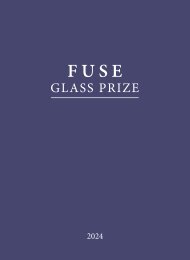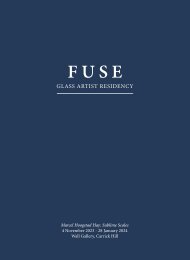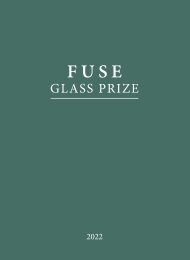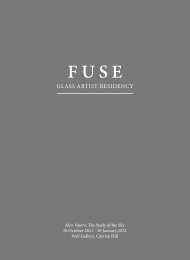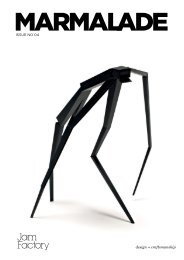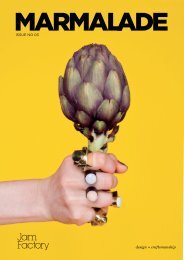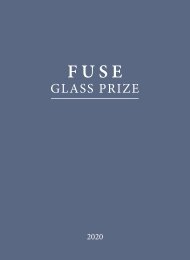Marmalade Issue 5, 2017
Create successful ePaper yourself
Turn your PDF publications into a flip-book with our unique Google optimized e-Paper software.
Beginnings are especially important when working with<br />
others. How you unfold your stories to each other can<br />
underpin the collaboration. Gray Street has opened me up<br />
to being both a mentor and a mentee on a daily basis. But<br />
the workshop is home territory and a certain amount of<br />
comfort and ease comes with that. I do know that travelling<br />
out of my comfort zone is critical for my practice, my brain<br />
and my body.<br />
Working in scientific and medical environments can<br />
sometimes feel alienating and I’ve found it’s always the<br />
human connections that melt these barriers. Over time I’ve<br />
learned to step back a little and slow down the judgement<br />
that can get in the way of learning something new.<br />
You have collaborated with Ian Gibbins for many years<br />
now. What do you feel he has brought to your practice<br />
and can you comment on what you have possibly brought<br />
to his understanding of the body and seeing through<br />
your artworks?<br />
My practice has been enriched through working with Ian<br />
and his colleagues over the course of a decade. Ian has<br />
commented that he became more aware of his teaching<br />
methods because of our discussions. As a result he would<br />
utilise his own body as a primary living resource in his<br />
teaching and encourage his students to do the same. He<br />
asked them to consider the generic nature of the body<br />
they were learning in medical school: ‘Whose body are<br />
you learning about? Is it yours?’<br />
Generally there’s never enough time during the courses<br />
to ask such philosophical questions like this about the<br />
subject matter. But these questions are crucial. So, yes,<br />
we have both been affected in really positive ways by<br />
working together.<br />
The title of the exhibition is no surface holds, expresses a<br />
slippage, an inability to create a solid, firm or definitive view<br />
or idea. Why is this expression so essential to your work?<br />
No surface holds is a line by the French feminist Luce<br />
Irigaray, from her book This Sex Which Is Not One written<br />
in 1977. Melinda Rackham used it as a chapter heading in<br />
her book on my practice. It’s a potent piece of writing to be<br />
sure. It’s about the dissolving of boundaries between two<br />
people. I’ve chosen it as an exhibition title and the title of an<br />
installation in the show.<br />
I think I’m illusionist at best and when I make an image or<br />
an object, the catalyst is usually a very transient impression,<br />
something fleeting, perhaps just a sensation. I become<br />
deliciously absorbed in the quest to make something<br />
tangible of that sensation and yet I know its actually<br />
impossible. I work with the notion that all knowledge is<br />
fluid and can be altered by something as simple as the<br />
shifting light.<br />
You are currently a visiting scholar at the Flinders Centre<br />
for Ophthalmology, Eye and Vision Research, School of<br />
Medicine, Flinders University, undertaking a project titled<br />
The nexus between vision, the eye and perception. The<br />
works of art you have produced in response to this include<br />
ocular plants, <strong>2017</strong> and ocular trees, <strong>2017</strong>. What are the<br />
similarities you are expressing between plants and the way<br />
the eye works or looks?<br />
When I started this latest residency I had no idea how broad<br />
the subject of eyes, perception and vision could be and<br />
the diversity of disciplines involved. Over the past year I’ve<br />
watched many eye surgeries, pretended to be a patient in<br />
the waiting rooms, had my eyes imaged with every machine<br />
available at the clinic, and visited the research labs and there<br />
is still so much to investigate.<br />
This residency is proving to be a little different from my<br />
previous experiences at Flinders. I often describe my role<br />
in these environments as being a kind of thinking two-way<br />
mirror and that’s the way I’ve worked with Ian in the past.<br />
I observe broadly to begin with and ask questions, share<br />
my observations and over time we may generate questions<br />
together and that’s a really wonderful experience.<br />
The work that has evolved so far reflects a quite personal<br />
response to the structure of the eye and an inquiry into the<br />
sensation of sight. I’m beginning to understand that eyes<br />
are small miracles.<br />
I’m intrigued by the intricate networks, which connect<br />
the eye to the whole body. Also how we process light<br />
into thought; it seems light is a key ingredient for vision<br />
and perception.<br />
The collections called Ocular Plants and Ocular Trees in<br />
the exhibition have evolved organically from serendipitous<br />
connections. Recently I asked Angela Chappell, the<br />
ophthalmic photographer to take images of my retinas and<br />
we spent some time studying them on screen together. It<br />
was like gazing through a science fiction-like portal into what<br />
looked like a glowing planet covered with an arterial lattice<br />
of rivers and streams.<br />
Seeing is a great way for us to finish, as the works of art in<br />
this exhibition definitely reward those that take the time<br />
to engage. What would you hope people take away from<br />
this exhibition?<br />
I hope that people sense something of the engagement I<br />
experience when I research and reflect and make. There<br />
are some tricks of the eye and a smattering of humour in<br />
the work. I hope they become absorbed in wonder, feel a<br />
little puzzled occasionally and even have a good laugh or<br />
two along the way. Andy Warhol once said, ‘I don’t know<br />
where the real starts and the artificial stops’. Sometimes,<br />
uncertainty is delicious.<br />
JamFactory Icon <strong>2017</strong>, Catherine Truman: no surface holds,<br />
opened in Adelaide as part of the South Australian Living<br />
Artists (SALA) Festival before touring to eight venues<br />
nationally. The exhibition tour has been assisted by the<br />
Australian Government’s Contemporary Touring Initiative,<br />
a program of the Australia Council for the Arts.<br />
Previous page: Ongoing Being (detail), 2010 - ongoing<br />
multi media, dimensions variable. Photographer: Grant Hancock.<br />
Top right: In Preparation for Seeing: SEM Glove, Installation – objects, 2015<br />
black cotton glove encrusted with black glass spheres, microscope slides, steel<br />
forceps, petri dishes, light pad, dimensions variable. Photographer: Grant Hancock.<br />
Right: no surface holds: Crab Claw Installation, 2015 - 17, found crab claws encrusted<br />
with glass spheres. Dimensions variable. Photographer: Grant Hancock.<br />
22 / ISSUE 05




